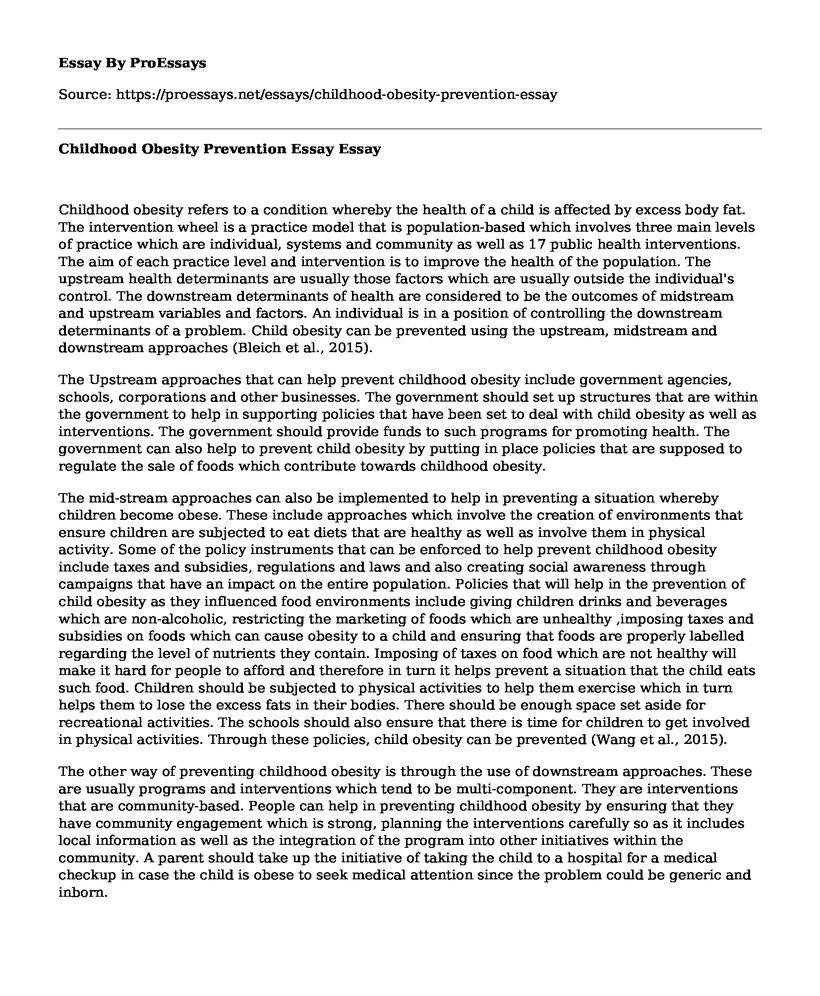Childhood obesity refers to a condition whereby the health of a child is affected by excess body fat. The intervention wheel is a practice model that is population-based which involves three main levels of practice which are individual, systems and community as well as 17 public health interventions. The aim of each practice level and intervention is to improve the health of the population. The upstream health determinants are usually those factors which are usually outside the individual's control. The downstream determinants of health are considered to be the outcomes of midstream and upstream variables and factors. An individual is in a position of controlling the downstream determinants of a problem. Child obesity can be prevented using the upstream, midstream and downstream approaches (Bleich et al., 2015).
The Upstream approaches that can help prevent childhood obesity include government agencies, schools, corporations and other businesses. The government should set up structures that are within the government to help in supporting policies that have been set to deal with child obesity as well as interventions. The government should provide funds to such programs for promoting health. The government can also help to prevent child obesity by putting in place policies that are supposed to regulate the sale of foods which contribute towards childhood obesity.
The mid-stream approaches can also be implemented to help in preventing a situation whereby children become obese. These include approaches which involve the creation of environments that ensure children are subjected to eat diets that are healthy as well as involve them in physical activity. Some of the policy instruments that can be enforced to help prevent childhood obesity include taxes and subsidies, regulations and laws and also creating social awareness through campaigns that have an impact on the entire population. Policies that will help in the prevention of child obesity as they influenced food environments include giving children drinks and beverages which are non-alcoholic, restricting the marketing of foods which are unhealthy ,imposing taxes and subsidies on foods which can cause obesity to a child and ensuring that foods are properly labelled regarding the level of nutrients they contain. Imposing of taxes on food which are not healthy will make it hard for people to afford and therefore in turn it helps prevent a situation that the child eats such food. Children should be subjected to physical activities to help them exercise which in turn helps them to lose the excess fats in their bodies. There should be enough space set aside for recreational activities. The schools should also ensure that there is time for children to get involved in physical activities. Through these policies, child obesity can be prevented (Wang et al., 2015).
The other way of preventing childhood obesity is through the use of downstream approaches. These are usually programs and interventions which tend to be multi-component. They are interventions that are community-based. People can help in preventing childhood obesity by ensuring that they have community engagement which is strong, planning the interventions carefully so as it includes local information as well as the integration of the program into other initiatives within the community. A parent should take up the initiative of taking the child to a hospital for a medical checkup in case the child is obese to seek medical attention since the problem could be generic and inborn.
Conclusion
In conclusion, various ways can be used to help in the prevention of childhood obesity which includes population-level actions. The government can help reduce child obesity by setting up various laws. Child obesity can also be prevented by ensuring that children have a healthy eating habit and also through physical activities.
References
Bleich, S. N., Segal, J., Wu, Y., Wilson, R., & Wang, Y. (2013). Systematic review of Community-based childhood obesity prevention studies. Pediatrics, 132(1), e201-e210.
Wang, Y., Wu, Y., Wilson, R. F., Bleich, S., Cheskin, L., Weston, C., & Segal, J. (2013). Childhood obesity prevention programs: comparative effectiveness review and meta- analysis.
Cite this page
Childhood Obesity Prevention Essay. (2022, Apr 14). Retrieved from https://proessays.net/essays/childhood-obesity-prevention-essay
If you are the original author of this essay and no longer wish to have it published on the ProEssays website, please click below to request its removal:
- The Montgomery Bus Protest Essay Example
- Essay Sample on Immigration: A History of Movement for Work & Settlement
- Research Paper on Empowering Girls Through Education: A Path to Sustainable Development
- Essay Example on Immigration to US: Florida & New York
- Essay on Vocational Driving Training Agency Eval: NYC Poverty, Jobs & More
- Essay Example on Discrimination in U.S. and Abroad: Pre-Civil War to Present
- Citizenship and Race - Free Essay Sample







